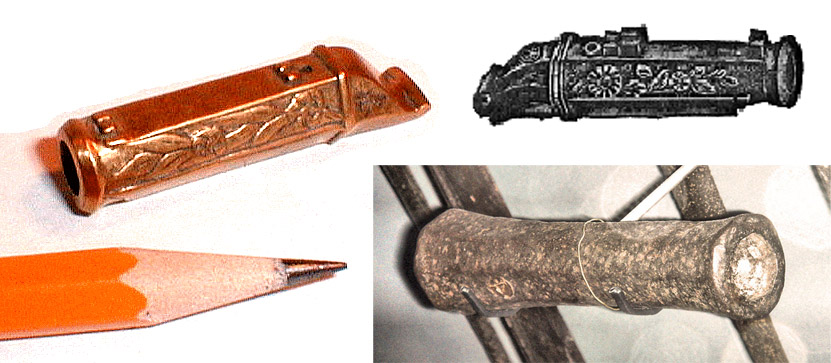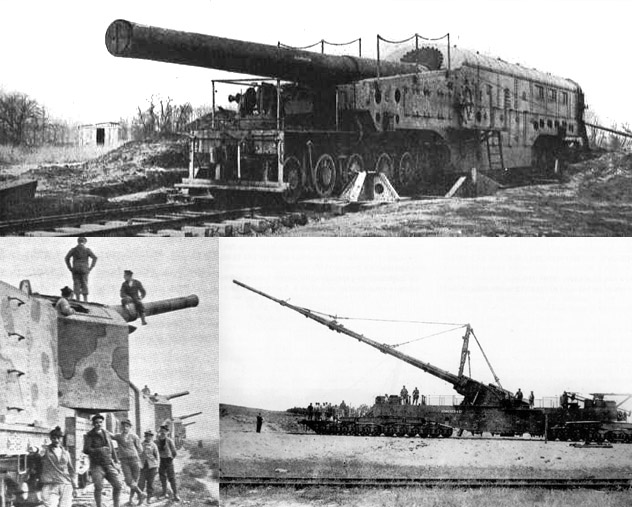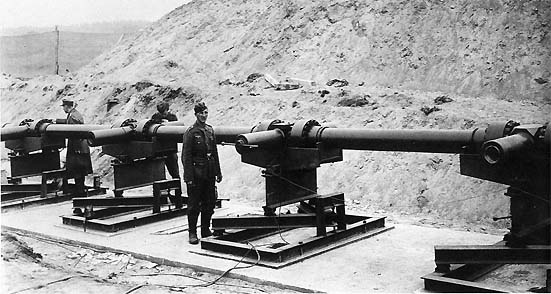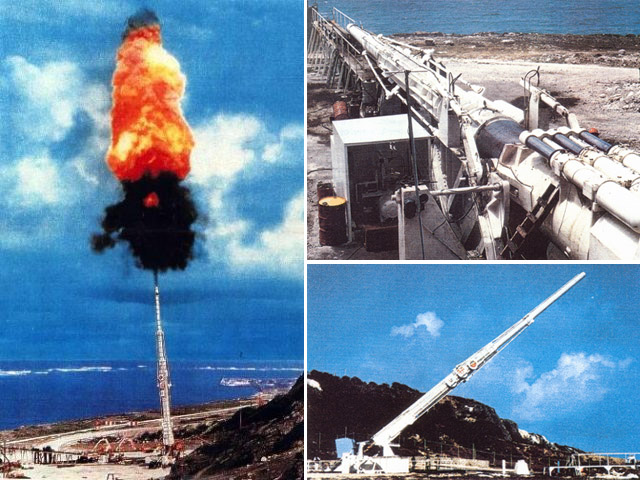 "QUANTUM SHOT" #453(rev) "QUANTUM SHOT" #453(rev) Link - article by M. Christian and Avi Abrams "It's not the size that counts but what you do with it"   (top image: Captured WWII Railroad Gun; image via) 1. Chinese Hand Cannons Although they aren't known for having the biggest cannons, the Chinese were definitely the first builders and also the first to point them at people they didn't like. For many reasons, though, they stopped using them, mostly because while the big guns terrified the folks they were pointed at, they also had a little defect. They blew up.  Chinese Hand Cannon - Bronze firearm, Yuan dynasty (1271-1368 AD). Photo by Yannick Trottier  A functional miniature replica of a Chinese Hand cannon, and a Hand Bombard, Europe 1380 Europeans really took to the idea of a thick metal cylinder, a charge of gunpowder, and a nasty surprise to hurl at people they didn't like. A first these early cannons were simple mortars: a lump of bell-shaped iron (because bell-makers were the first cannon-makers) with a hole for the charge and the shell. They still exploded as often as they fired, but unlike the Chinese, the Europeans thought the bang was worth the buck. As long as someone else lit the fuse, that is. Once they got that whole "exploding in your face" thing fixed, or at least tuned down to a dull roar, they began to really play the "mine is bigger than yours" game. 2. The First True Supergun The first true "supergun" was The Great Turkish Bombard, which was also called the Dardanelles Gun, the Royal Gun, the Hungarian Cannon, Muhammed's Great Gun or the less common but more honest "Good Lord, Look at the Size Of That Thing."  Built in 1453 in Hungary and used by turks to conquer Constantinople, they shocked their builders by unexpectedly doing what they were designed to do: lobbing a 1,500 pound granite sphere at whoever they were pointed at. 3. Tsar's Bragging Monster Not to be outdone, the Russians swaggered up with their own Mutually Assured Demolisher. Forged in 1585, the Tsar Cannon was a 35-inch-wide yawning monster designed to toss 800 pounds of grapeshot -- a whole lot of little cannon balls instead of one big one. The Tsar Cannon was never fired, but that didn't stop the Russian military from boring everyone by bragging about how huge it was.   (image credit: Will) Another huge cannon: Mons Meg, made in 1449 and actually fired for almost 200 years - is now located at Edinburgh Castle, Scotland:  (image via) 3. Trench Horror Upgrade It's said that the first world war was truly the first modern war. Poison gas, tanks, air combat, the machine gun -- they were all gleefully experimented with during those years of trench horror. But the classics were used as well, the old standby of thick metal cylinder, a charge of gunpowder, and a nasty surprise, never really going out of style. But as this was a modern war, the classic cannon got a big -- a very big -- upgrade as well. It's odd that such a monster got a woman's name, but the always-romantic Krupp engineers did just that: smashing champagne over the 17-inch-caliber gun, they christened it after their boss's -- possibly zaftig -- daughter. Big Bertha, or more accurately "Fat Bertha" was a hit with the German military, showing the Belgians at Liège, Namur and Antwerp, and the French at Maubeuge who had the really big one.  (image courtesy of C. Luzent, les Canons de l'Apocalypse)  (images via) But that wasn't enough. Sure Bertha had the thickness and the length, but what the Germans wanted was something to really show off -- especially since those swaggering Americans were about to enter the game. 4. Long Max to follow Big Bertha Searching for something they could get to their Eastern Front, German military engineers glanced out at sea and hit on the idea of transplantation instead of simple enhancement . To put it simply, the Long Max was a naval gun, the biggest one the Germans had. Luckily it quickly got its land legs: on the battlefield it showed its potency by shooting off 1,600 pound shells a respectable distance ... of 30 miles.  (Comparison of 30.5 cm/50 and 38 cm/45 guns, image by Peter Lienau) A naval ordnance on wheels - a 14in., 30 mile gun... an entire train composed of rail artillery...  (images via) 5. The First Terror Weapon But that wasn't enough. The Paris Gun wasn't named because it reminded those warm-hearted Krupps of the famous City Of Light. Hardly. Another transplanted naval piece, the gun has sometimes been called the first terror weapon.  Although it needed a lot of maintenance, didn't shoot anything very heavy or destructive, but it still horrified that romantic city by dropping shells from ... wait for it ... 80 miles away.   It was a monster to the Germans as well -- mounted on a special train carriage, it was so loud that a set of regular artillery was fired along with it to hide its thunderous discharge. Side note: Dr. Kapitza proposed an interesting Electric Cannon in 1932, which would use no gun powder, generating noiseless magnetic explosions - a sort of silent "Big Bertha":  "SILENT guns sending their whistling messengers of death into the sky at speeds far beyond those now attained by powder-driven shells..."  (images via, click to enlarge) 6. The Largest Gun Ever Built Then, as Monty Python said, peace broke out and everyone got much more polite about the size of their ammunition. Howitzers and field pieces tucked away, the refined gentleman nations of the world played croquet and gin rummy for a few decades until someone -- that is, Germany -- decided to wave their barrels and calibers in everyone's faces.  No doubt about it, the Schwerer Gustav certainly was impressive. Like the old Paris gun, this monster belonged to the German Navy, but unlike the piece that had frightened the City of Light, the Schwerer Gustav was more than a thunderous braggart.  First gun was named "Gustav", the second - "Dora":   The monster was so huge it took a team of 2,500 "volunteers" to lay track for it, and the train carrying and supporting it was 25 cars long, about a mile. (See the rare video of "the biggest gun in the world" firing here) Unlike the Paris version, it only had a range of about 30 miles, but this one could throw a shell that didn't weigh just 1,000, 2,000, or even 3,000 pounds -- the damned thing could fire a 7,100-kilogram shell! (That's more like 15,620 (US) lbs)  (right image credit: Pepe Garcia) Another gun from that era: K-5E "Leopold"   (images credit: one35th.com) See the 3-D drawings of various German railway guns on this page, made by Greg Heuer:  7. The Centipede Supergun The Germans weren't the only ones obsessed with the size of their guns. The Brits and the Americans were not to be outdone, but they certainly seemed to be constantly looking down at their drawing boards, and wondering how their guns could be even bigger. Before peace again broke out, Germany had one last idea, a gun that, once and for all, would given them ultimate bragging rights.  What makes the V3 Hochdruckpumpe ("High Pressure Pump", or "Centipede") gun so interesting is that it wasn't one gun but a bunch of smaller ones that fired in precise order to kick its shell faster and faster. Part of the whole Victor Weapon package that included the V1 Buzz Bomb and the V2 (the first ballistic missile), the V3 was to be permanently mounted in a concrete fortress in France where it would have blasted a 300-pound shell more than 100 miles, straight into the heart of London - the Yanks and the Brits, however, blasted the gun into oblivion before it was ready to fire back. 8. More-Than-Supergun to reach stratosphere Things got coolly polite after the war. We and They still obsessed over the sizes of our pieces, but new toys had begun to seriously threaten the satisfyingly primal big bang of massive artillery. Missiles, luckily, hadn't completely stolen the show. Back in '61 two superpowers, the US and ... Canada? ... worked with the genius gun-designer Gerald Bull on the HARP system, a more-than-supergun designed to reach to the edge of the stratosphere.  Like those charming folks at Krupps, Bull loved his guns. After HARP went nowhere, Bull tried to find someone else to back his idea of a true supergun, a piece to end all pieces. His ultimate project was called Project Babylon, and while Bull's final intentions are a bit hazy, no one doubts that what he really wanted to do was make a gun big enough to do what HARP didn't have a chance to do: fire something into space.  Bull was a genius. But he was profoundly stupid in one very crucial way: his choice of clients. After knocking on all kinds of doors for Project Babylon sponsors, he finally managed to secure the backing of the president of a Middle Eastern country, who'd write the checks if Bull the gun master would build the biggest one in human history. 9. Saddam's Supergun spells doom for its inventor The problem was the signature on those checks belonged to Saddam Hussein (more info), and a lot of his neighbors began to get kind of ...well, twitchy about someone like Hussein being able to wave Bull's massive piece around, especially, if Bull had succeeded, it would have been able to fire a shell almost 500 miles.  (image credit: fas.org) In the end Bull didn't succeed, not because of poor engineering but because of a considerably smaller gun. A tiny thing, really, compared to what he wanted to show the world. But, as the old saying goes, it's not the size that counts but what you do with it. And the Mossad (the Israeli Secret Service) knew just what to do with their small gun: put a tiny bullet in the brain of the man who was building a supergun for Saddam Hussein. Article by M. Christian and Avi Abrams, Dark Roasted Blend. CONTINUE TO DRB MILITARY CATEGORY ->
|
Sabtu, 26 Juli 2008
The Biggest Guns in Human History
Langganan:
Posting Komentar (Atom)



Tidak ada komentar:
Posting Komentar